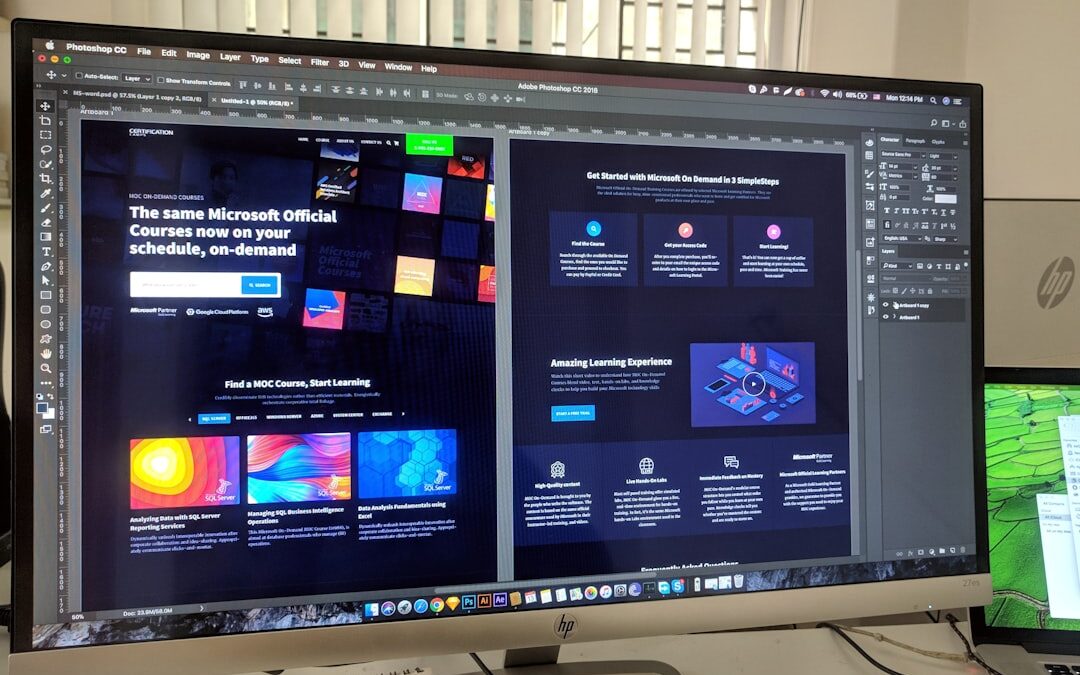Importance of Web Design in Digital Marketing: 5 Essential Tips
The importance of web design in digital marketing strategy cannot be overstated. Where 5.18 billion people are online, getting your website design right is crucial for success. Here’s why it’s so important:
- First Impressions Matter: A well-designed website ensures a strong initial impression, drawing visitors in and keeping their interest.
- Trust Building: Quality web design fosters trust and credibility, enhancing brand reliability.
- SEO Boost: Good web design improves search engine performance, driving organic traffic and increasing visibility.
- User Experience: An intuitive and responsive design delivers a seamless user experience, which is crucial for keeping visitors engaged.
I’m Randy Speckman, founder of Randy Speckman Design. With 15 years of experience, I’ve helped over 500 entrepreneurs harness the power of website design to improve their digital marketing efforts and increase sales. Let’s explore how strategic web design can transform your marketing strategy.

The Importance of Web Design in Digital Marketing Strategy
When it comes to digital marketing, your website is your storefront. It’s where your audience forms their first impression of your brand. And as they say, “You never get a second chance to make a first impression.”
First Impressions Matter
Imagine walking into a store where everything is chaotic and hard to find. You’d likely walk out, right? The same goes for websites. A clean, well-organized site invites visitors to stay and explore. Research shows that it takes just 50 milliseconds for users to form an opinion about your website that determines whether they’ll stay or leave.
Building Brand Reliability
A well-designed website does more than look pretty. It builds trust. When users see a professional, polished website, they feel more confident in the reliability of your brand. On the flip side, a poorly designed site can make users question your credibility. Think of it this way: If your website looks outdated or is difficult to steer, visitors might wonder if your services or products are outdated too.
Boosting SEO Performance
Web design plays a crucial role in search engine optimization (SEO). Search engines like Google prioritize user experience, so a well-designed website is more likely to rank higher in search results. Key elements like fast loading times, mobile optimization, and clean code are essential for SEO success.
For example, if your website is slow to load, users will leave, increasing your bounce rate and negatively impacting your SEO. Similarly, mobile-friendliness is no longer optional; with over half of web traffic coming from mobile devices, a responsive design is a must.

Conclusion
Incorporating strategic web design into your digital marketing strategy is not just beneficial—it’s essential. It influences first impressions, builds brand reliability, and improves SEO performance, all of which are vital for digital success.
Next, let’s explore how enhancing user experience can further boost your digital marketing efforts.
Enhancing User Experience
A great user experience is the backbone of any successful website. It’s all about making sure visitors can steer your site easily, whether they’re on a desktop or a mobile device. User-friendly design is key to keeping users engaged and encouraging them to take action.
Simplified Navigation
Think of your website as a map. If users can’t find their way around, they’ll leave. Simplified navigation means organizing your site so that visitors can find what they’re looking for quickly and easily. Use clear labels, logical menu structures, and a consistent layout to guide users smoothly from one page to another.
A study by the Nielsen Norman Group found that users spend most of their time on websites looking for information. If they can’t find it, they’re likely to leave. So, make sure your navigation is intuitive and straightforward.
Mobile Optimization
With 92% of online activities happening on mobile devices, mobile optimization isn’t just a nice-to-have—it’s a necessity. A mobile-friendly website adjusts seamlessly to different screen sizes, ensuring that users have the same great experience whether they’re on a phone, tablet, or desktop.
Google considers mobile-friendliness a key ranking factor. If your site isn’t optimized for mobile, you risk losing both visitors and SEO ranking. Responsive design, fast loading times, and touch-friendly interfaces are crucial for mobile optimization.
User-Friendly Design
A user-friendly design is about more than just aesthetics. It’s about creating a site that’s easy to use and understand. Stick to standard design practices, like using familiar icons and layouts, so users know what to expect.
Engaging content, clear calls to action, and a logical flow all contribute to a positive user experience. If users find your site difficult to use, they’re likely to leave and not come back.
In summary, enhancing user experience through effective navigation, mobile optimization, and a user-friendly design is essential for keeping visitors engaged and happy. Up next, we’ll dive into how these elements can also boost your site’s visibility and SEO performance.
Boosting SEO and Visibility
Web design plays a critical role in boosting SEO and visibility. How your site looks and functions affects how search engines rank it, which in turn impacts your organic traffic. Let’s explore how web design ties into search engine optimization (SEO) and why it’s so important for your digital marketing success.
Search Engine Optimization (SEO)
SEO is all about making your website more visible to people who are searching online. It involves using specific strategies to improve your site’s ranking on search engines like Google. A well-designed website is crucial for effective SEO.
-
Faster Loading Times: Websites that load quickly rank higher. Make sure your images are optimized and your code is clean to speed up loading times.
-
Mobile Responsiveness: A responsive design ensures your site looks good on any device. Google prioritizes mobile-friendly sites in search results, so this is a must.
-
Proper Structure: Organize your content so search engines can easily crawl and index your site. Use headers, bullet points, and a clear hierarchy to make content accessible.
-
High-Quality Content: Unique, relevant content is king. Avoid duplicate content, as it can harm your rankings.
Organic Traffic
Organic traffic refers to visitors who find your site through unpaid search results. A strong SEO strategy increases organic traffic, which is often more valuable than paid traffic because it indicates genuine interest.
A case study from Global Media Insight shows that businesses with well-optimized websites see a significant increase in organic traffic. By focusing on SEO-friendly web design, you can attract more visitors who are searching for what you offer.
Google Algorithms
Google’s algorithms determine how websites are ranked. They consider factors like relevance, quality, and user experience. Staying updated with algorithm changes is vital for maintaining and improving your site’s visibility.
For example, Google penalizes sites with duplicate content. Ensure each page has unique content and use alt tags for images to help search engines understand your site better.
In conclusion, integrating SEO into your web design is essential for improving visibility and attracting organic traffic. Up next, we’ll look at how optimizing conversion rates can further improve your digital marketing strategy.
Optimizing Conversion Rates
When it comes to digital marketing, optimizing conversion rates is like turning website visitors into loyal customers. It’s all about making your site so inviting and easy to use that people can’t help but take action, whether that’s signing up for a newsletter or buying a product.
Conversion Rate Optimization (CRO)
Conversion Rate Optimization (CRO) is the practice of increasing the percentage of users who complete a desired action on your website. A well-designed site can significantly boost these rates. Here’s how:
-
Simplify Navigation: Make it easy for users to find what they’re looking for. Clear menus and intuitive layouts prevent frustration and keep visitors engaged.
-
Streamline Forms: Shorten your forms. Ask only for essential information. The fewer fields, the higher the chances users will complete them.
-
A/B Testing: Test different versions of a page to see which one performs better. This helps identify what elements drive conversions.
Call-to-Action (CTA)
A strong call-to-action (CTA) is crucial for guiding users towards conversion. Think of it as a friendly nudge that tells them what to do next. Here are some tips for effective CTAs:
-
Be Clear and Direct: Use action words like “Get Started”, “Sign Up Now”, or “Buy Today”. These words tell users exactly what to do.
-
Create Urgency: Phrases like “Limited Time Offer” or “Only a Few Left” can encourage immediate action.
-
Strategic Placement: Place CTAs where they are easily seen, like above the fold or at the end of a blog post. A floating CTA button can also keep it visible as users scroll.
User Engagement
User engagement is about keeping visitors interested and interacting with your site. Engaged users are more likely to convert. Here’s how to improve engagement:
-
Interactive Content: Use quizzes, polls, or videos to make your site more interactive. This not only keeps users on your page longer but can also lead to higher conversion rates.
-
Personalized Experience: Tailor content and recommendations based on user behavior. This makes users feel valued and understood, increasing the likelihood of conversion.
-
Feedback Options: Allow users to leave reviews or comments. This interaction can build community and trust, encouraging others to engage and convert.
By focusing on these strategies, you can significantly improve your website’s conversion rates, turning visitors into customers and enhancing your overall digital marketing strategy. Up next, we’ll explore how building a strong brand image ties into web design and digital marketing success.
Building a Strong Brand Image
Building a strong brand image is crucial in digital marketing. It’s more than just a logo; it’s how people perceive your brand, trust it, and recognize it consistently across platforms.
Brand Perception
Brand perception starts the moment someone lands on your website. A well-designed site gives visitors confidence in your brand’s professionalism and reliability. Think of your website as the digital storefront of your business. If it looks outdated or cluttered, visitors might question the quality of your products or services.
A case study from Forbes highlights how aligning web design with brand identity fosters a positive perception. A consistent design, from color schemes to typography, helps users immediately recognize your brand and feel comfortable exploring further.
Building Trust
Trust is built through consistency and reliability. A website that functions well, loads quickly, and provides clear information is more likely to earn visitor trust. According to Social Media Today, short loading times and a lack of broken links contribute significantly to user trust. If your site is slow or full of errors, users might leave and never return.
Moreover, regularly updating your content and design shows that your brand is active and attentive to user needs. This ongoing attention to detail reassures visitors that they can rely on your business.
Consistency Across Platforms
Consistency is key to a memorable brand image. Use the same logo, colors, and messaging across all digital platforms—your website, social media, and email campaigns. This uniformity helps reinforce your brand identity every time someone interacts with your business.
For instance, placing your logo prominently on your website, as noted by Social Media Today, ensures that your brand is always at the forefront of a visitor’s mind. This small detail can significantly impact how your brand is remembered.
Incorporating these elements into your web design not only strengthens your brand image but also improves your digital marketing strategy. Next, we’ll address frequently asked questions about how web design influences various aspects of digital marketing.
Frequently Asked Questions about Web Design in Digital Marketing
How does web design affect user engagement?
Web design plays a crucial role in user engagement. A visually appealing and easy-to-steer website encourages visitors to stay longer and explore more content. According to Social Media Today, a site that’s easy to use and has clear, concise information keeps users interested and engaged.
Consider a story from Randy Speckman Design where a client redesigned their site to improve navigation and saw a significant increase in user interaction. By simplifying the layout and enhancing the user interface, visitors found it easier to find what they were looking for, leading to higher engagement rates.
Can web design influence social media marketing success?
Absolutely! A well-designed website can improve social media marketing efforts by serving as a share-worthy platform. When users find your website visually appealing and informative, they’re more likely to share content on social media, increasing your brand’s reach.
As highlighted by Investopedia, digital marketing strategies rely on creating content that resonates with audiences. A cohesive design that aligns with your brand’s social media presence ensures that users have a seamless experience, whether they’re on your site or your social media pages.
Will an outdated website design affect digital marketing initiatives?
Yes, an outdated website design can severely hinder digital marketing efforts. An old-fashioned or clunky design may drive potential customers away, as it suggests that the brand is not keeping up with current trends or technologies. Social Media Today notes that slow loading times and poor functionality can lead to high bounce rates, negatively impacting SEO and conversion rates.
For instance, a client at Randy Speckman Design experienced a drop in traffic due to an outdated design. After a redesign, they saw improved user retention and engagement, proving the importance of keeping web design fresh and relevant.
These insights emphasize the importance of web design in digital marketing strategy. A well-crafted site not only attracts and retains users but also supports broader marketing goals. Next, we’ll explore how web design impacts conversion optimization.
Conclusion
A well-designed website is more than just a pretty face; it’s a powerful tool that can drive business success. At Randy Speckman Design, we understand the importance of web design in digital marketing strategy. Our expertise in digital strategy and conversion optimization ensures that your website not only looks good but also performs exceptionally well.
Digital Strategy is at the heart of what we do. We believe that a strategic approach to web design can transform how a business engages with its audience. By integrating elements such as SEO, user experience, and mobile optimization, we help businesses create a seamless online presence that captures attention and drives traffic.
Conversion Optimization is another key area where we excel. A website should not only attract visitors but also convert them into customers. Through effective design strategies, including clear calls-to-action and user-friendly layouts, we improve the likelihood of visitors taking desired actions, whether it’s making a purchase or signing up for a newsletter.
Our work with clients has shown that a thoughtfully designed website can lead to significant improvements in conversion rates. For instance, a client who revamped their site with us saw a marked increase in customer engagement and sales. This success story underscores the vital role that web design plays in achieving marketing objectives.
In summary, a strong web design is crucial for any digital marketing strategy. It supports brand image, boosts SEO, and maximizes conversions. At Randy Speckman Design, we are committed to helping businesses thrive online. If you’re ready to lift your digital presence, explore our marketing strategies to see how we can help you succeed.




